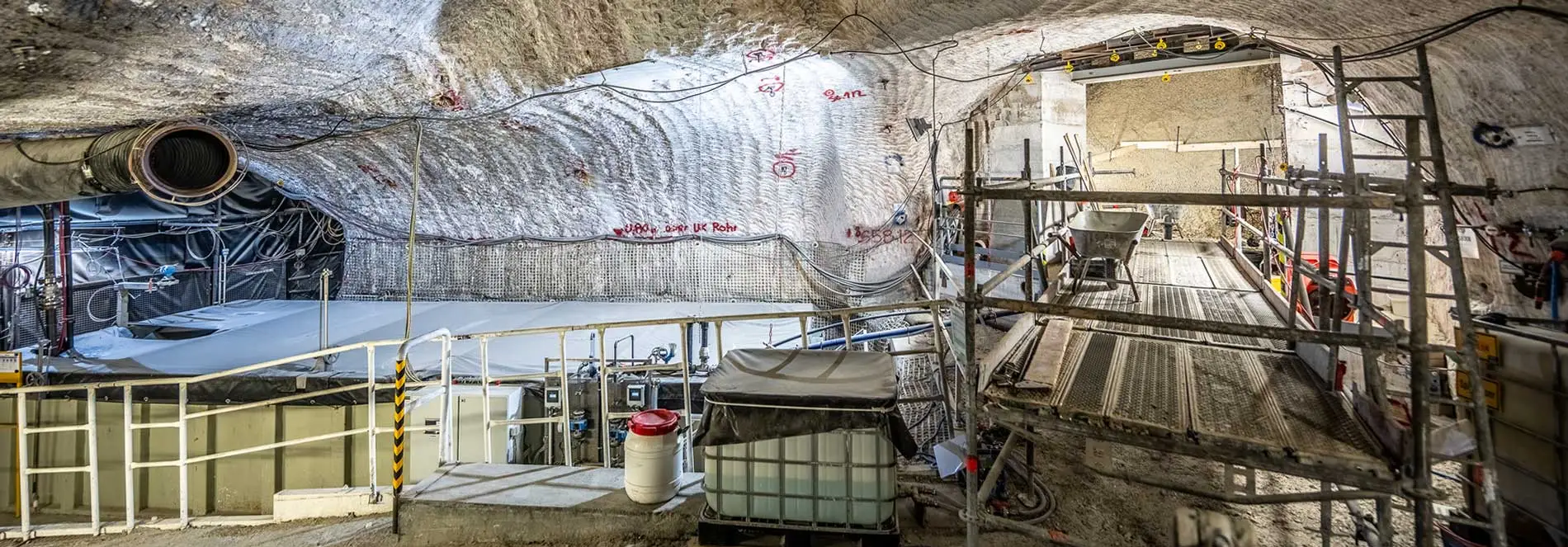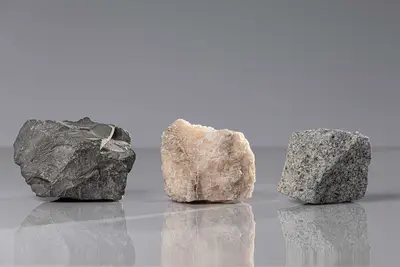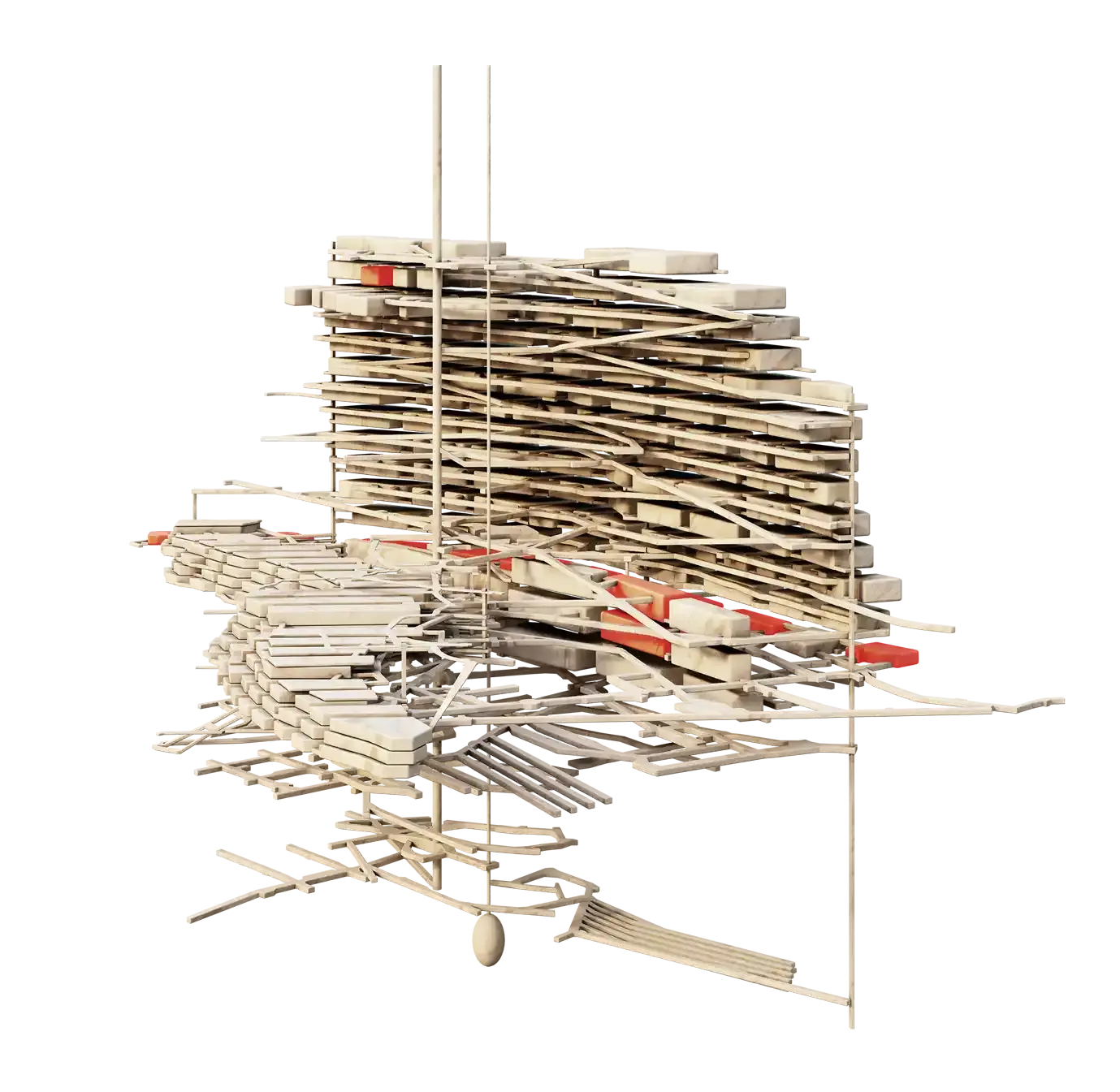
Main topic: Salt water in the Asse mine
Water has been seeping into the Asse II mine for decades, resulting in a risk of what is known as “drowning”. Miners use this term to describe a situation in which so much water enters a mine that it is no longer safe to work in it and the mine must be abandoned.
Around 12 cubic metres of solution per day are currently seeping into the mine through cracks in the surrounding rock and salt. This volume is equivalent to about 50 bathtubs. Even the experts from the BGE cannot predict how the rate of influx will vary over time, and it could change at any time in such a way that safe operation of the mine was no longer possible. In this case, the retrieval of radioactive waste would have to be abandoned.
On this page
Causes and background
Over decades of intensive salt mining, miners created numerous cavities in a very confined space, especially on the southern edge of the salt structure. These cavities are permanently exposed to rock pressure and are being slowly but steadily compressed. The movement of the rock creates cracks that allow water to penetrate into the mine.
A blessing in disguise: the penetrating water contains large quantities of salt. Experts describe this as a saturated rock salt solution, meaning that the solution cannot dissolve any new rock salt and thereby enlarge the flow pathways. Rock salt is the term used by miners to refer to sodium chloride, also known as common salt. There are also other types of salt, such as various potassium salts.
Incidentally, the amount of water in the mine is independent of the amount of rainfall above ground, because the water first travels through the rock for very long periods of time before penetrating into the mine. In other words, we don’t collect more water underground in times of higher rainfall.
Diagrams: Intensive salt mining has left its mark on the Asse II mine. The resulting cavities were later largely backfilled, thereby stabilising the facility. The diagrams show all the cavities that ever existed in the Asse II mine – which were never open at the same time – as well as the mine in 2015, when numerous cavities had already been filled in.
Not all water is the same
There are around 570 spots in the Asse II mine that are slightly damp or dripping. These spots often dry up on their own. In other places, the BGE collects the solution on a continuous basis. The most important collection point is the so-called main collection point at a depth of 658 metres (see diagram). This point is located around 100 metres above the emplacement chambers containing radioactive waste at the 750-metre level. At the main collection point, the BGE experts are currently collecting around 95% of the salt solution leaking into the Asse II mine (type A solution). This had no contact with the radioactive waste.
An additional 1 cubic metre of salt water per day is collected below the main collection point (type B solution). This solution also had no contact with the radioactive waste.
Further down in the mine, salt water that has come into contact with the radioactive waste and is contaminated is also collected. This comes to a small amount, averaging around 15 litres per day (type C solution).
How is the salt water monitored?
No matter where the BGE collects the solution, it undergoes intensive analysis. Among other things, checks are made of the following:
- volume of influent solution
- salt content
- temperature
- density.
The solution is also analysed for radioactive substances, with tritium playing a particularly important role in this context.
Tritium is a radioactive variant of hydrogen and originates from the stored waste. As this radioactive substance is gaseous and so small, it can escape from the emplacement chambers through extremely fine cracks and is absorbed on contact with the underground solution. However, measurements show that the solution from the main collection point (type A solution) contains only around a tenth of the quantity of tritium that would be permitted in drinking water.
The collected salt water also contains traces of other radioactive substances that originate from the surrounding rock and have been absorbed by the water on its way through the rock mass. These substances are of natural origin and have nothing to do with the nuclear waste in the Asse II mine.
How is the salt water disposed of?

Main collection point
The solution collected at the main collection point and cleared from a radiological perspective leaves the Asse II mine every three weeks. It is handed over to a certified specialist company from the chemical industry in order to recycle the salt. The solution is radiologically harmless.
The solution arising at other collection points remains in the mine and is generally not radioactively contaminated. It is used in the mine to produce concrete, which the miners use to fill in residual cavities with a view to stabilising the mine. If the solution can only be collected after it has come into contact with the radioactive waste (type C solution), this usage is only possible to a limited extent. If the radioactive contamination is comparatively low, the BGE also uses this solution to make concrete in the deepest areas of the mine. This procedure has been authorised by the state mining office and ensures that the radioactive substances contained in the concrete no longer reach the surface.
If the solution has a higher level of contamination, however, it is declared as radioactive waste and handed over to the state collection point of Lower Saxony. This rarely happens, however, and only applies to a few litres of solution.
Will the disposal options remain constant?
The BGE is constantly exploring other disposal options. It is important to do so because the mine can only be operated safely in the long term if the solution can be handed over on a regular basis.
For example, the BGE currently only hands over type A solution, which is collected above the 700-metre level and is well below the limit value for tritium in the Drinking Water Ordinance. This voluntary commitment can only be met if the quantity of solution arising does not increase significantly below the 700-metre level. Since significantly larger quantities of water cannot be utilised underground, a disposal option would then have to be identified outside the Asse for type B solution in order to ensure continued safe operation of the mine. Since type B solution also has no contact with the waste, radiological clearance appears to be possible. Ultimately, the requirements of the Radiation Protection Act are decisive when it comes to the disposability of the solutions.
Is there no better way to seal the mine?

Stabilisation work
There is no way to seal the mine so that no more solution can enter. This is because the rock on the southern flank has been extensively loosened by rock displacement into the mining areas, and blocking one route would lead a new one to break open.
It is important to stabilise the mine, and the BGE therefore backfills all cavities that are no longer required for the recovery of radioactive waste. This causes the mine to deform more slowly, as empirical values have already shown.
It is impossible to predict how long the mine can be operated safely. An important prerequisite for the retrieval of waste is that the main collection point can be operated in a stable manner or alternative methods can be found for salt water management.
Questions and answers
Is more salt water flowing into the Asse?
Salt water has been flowing into the Asse mine since 1988. So far, a large part of this salt water has been collected at a depth of 658 metres at the so-called main collection point. This salt water is then tested for possible radiological contamination and pumped above ground. The situation has changed since the start of the year, and a greater volume of salt water is now being collected at several points below 658 metres than at the main collection point.
Is there an increase in contaminated solutions at the 750-metre level?
Most of the radioactive waste lies at a depth of 750 metres. It is located in the former mining chambers of the old salt mine, which dates back more than 100 years. A measuring programme is being deployed there to check whether salt water comes into contact with the waste and therefore becomes contaminated. The measurements at the 750-metre level currently give no indication of an increase in contaminated solutions.
Are contaminated solutions escaping at the surface?
There is no evidence that contaminated salt water reaches the surface, nor is this to be expected in the immediate future. Based on current knowledge, it would take several hundred years for radioactive substances to reach the surface.
Would a release in several hundred years make the area uninhabitable?
It is impossible to make a detailed calculation of the potential level of radiation exposure in the future, as this depends on the exact course of release. Possible scenarios range from exposure below the permissible limits to a slight exceeding of the limits. A large-scale evacuation is not to be expected.
Is it still possible to retrieve the radioactive waste?
The BGE is continuing to pursue the retrieval of radioactive waste, and planning is ongoing.
The BGE will only be able to say how current events affect retrieval planning once it has more information on how current events unfold and the plans have been reviewed accordingly. The BGE has been implementing precautionary measures to stabilise the mine for years. These precautionary measures are part of emergency planning and constitute a prerequisite for the retrieval of radioactive waste.
Will the mine now be flooded?
Cross-flooding the mine is part of the emergency measures set out in the emergency planning. These measures will be implemented if the influx of solution increases to such an extent that it is no longer technically controllable. This is not currently the case.
What is the BGE currently doing?
At present, miners are gradually working their way into the main collection point at the 658-metre level within the secured area in order to locate potential damaged areas of containment liner that are accessible and to carry out appropriate repairs.
In April 2024, the BGE made an application for complete renovation of the main collection point at the 658-metre level. This project will be pursued further. The application has been submitted to the State Office for Mining, Energy and Geology (LBEG), which is the competent authority in this instance. As part of the application, the BGE requested that the LBEG allow necessary exploratory work to begin in advance of renovation based on a partial licence.










